Ex-workers say ostriches die ‘in huge numbers’ at farm south of Boise. What the owner says
It was a frigid weekday morning in January, and Amanda Worman had just made the 20-minute commute to her job at a remote ostrich farm south of Boise. What she saw when she arrived stopped her in her tracks.
For months, Worman, who handled and cared for the ostriches at American Ostrich Farms, had been raising the alarm about the animals’ living conditions — she said she told her supervisors on several occasions that the birds, most of them kept in outdoor enclosures, had inadequate shelter and would suffer as the winter weather worsened.
She said she asked to move the birds that were underweight or featherless to the farm’s propane-heated greenhouses. She managed to bring in nearly 100 ostriches before a cold snap pressed in. But dozens of others were left outside, she said.
“I was fighting to get them moved,” Worman said. “And everyone kept ignoring me.”
Worman went public with her concerns and contacted the People for the Ethical Treatment of Animals, or PETA, which lodged a complaint with the Idaho Department of Agriculture. The department sent an investigator, who reported no evidence of abuse during a visit to the farm and “found no deficiencies” in a follow-up inspection several weeks later.
A spokesperson for PETA said the nonprofit has since spoken with five other former employees who corroborated Worman’s allegations.
The farm denies that animals were abused and suggests that former workers had malicious motives. The company says on its website that it’s driven by ethical practices and prioritizes humane treatment.
Worman said she was fired for speaking up about the animals’ conditions. And the farm’s former animal husbandry manager says she was fired in retaliation for cooperating with the state’s investigation. They agreed to speak on the record with the Idaho Statesman.
Owner tries ostrich, starts farm
Alex McCoy founded American Ostrich Farms in 2014.
McCoy, 42, spent his early career in investment banking and venture capital before taking on positions in public and private international finance, according to his biography on the company’s website. He first encountered ostrich in South Africa in 2012, when “weary of an athlete’s diet” while training for an Ironman Triathlon, he ordered an ostrich steak to satisfy a craving. An hour after eating, he ran his fastest 16 miles, the bio says. McCoy started American Ostrich Farms a couple of years later.
Ostriches are native to sub-Saharan Africa. The 120-acre farm in southeast Kuna is one of a couple hundred farms in the U.S. that breed them and raise the chicks, selling the meat, feathers, egg shells, oil and other byproducts after slaughter.
American Ostrich Farms is located miles past the rock pits and state prisons off South Pleasant Valley Road. It sits behind a security gate, with its farmhouse at the end of a long gravel path lined with sagebrush and dry cheatgrass.
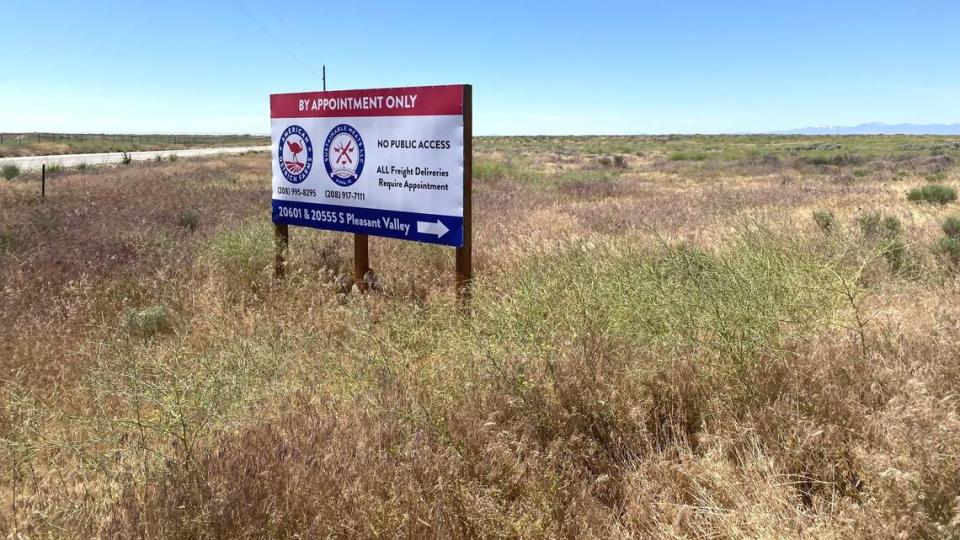
The ostriches are separated into groups based mostly on age. The farm has about 90 breeding pens, each filled with one rooster and two to three hens, Jessica Jimenez, the farm’s plant manager, told the Statesman during a tour of the property. Nearby “grower” pens house dozens of male and female birds deemed too young or unsuitable to breed.
An incubation shed by the farmhouse has the capacity to nurture about 800 eggs. During mating season, which runs from February through late September, one to three eggs hatch a week, Jimenez said.
Behind the enclosures is an on-site slaughterhouse, Sustainable Meats, a subsidiary of American Ostrich Farms that opened in 2022. That’s where the ostriches are processed and packaged into steaks and other products.
Worman, 37, worked at American Ostrich Farms for about six months starting in late August. She said she grew up watching her father, a farrier, trim and shoe horses’ hooves. She had been living in Kuna and looking for ranch-hand work when she saw that there was an ostrich farm in the area.
“I just thought, ‘Oh wow, that’s super cool,’ ” she said by phone. “I started calling them nonstop for a couple of months and finally talked them into hiring me.”
Worman said she was hired at $20 an hour and earned $20.25 by the time she was fired.
She was responsible for documenting the birds’ condition and that of their enclosures, according to a spokesperson for the farm.McCoy said it was an entry-level position.
Many birds ‘suffered for no reason,’ former employee says
Worman arrived around 8 a.m. that January day dressed in extra layers. She said she parked her car by the farmhouse, clocked in and began her rounds, which included checking all the birds and making sure they had food and water.
When she got to the breeding pens she found two ostriches sitting on the ground, she said. So she entered the pen, cordoned off by wire and steel posts, and inspected the birds. She said she realized they couldn’t stand because their legs and feet were frozen.
“You could squeeze their legs and it was like grabbing a frozen chunk of meat in the store,” Worman said.
She called the farm’s animal husbandry manager at the time, Sarabeth Henderson, to evaluate the birds. Henderson told the Statesman by phone that both ostriches had frostbite. One had swelling so severe that the back of its foot split open, exposing the bone.
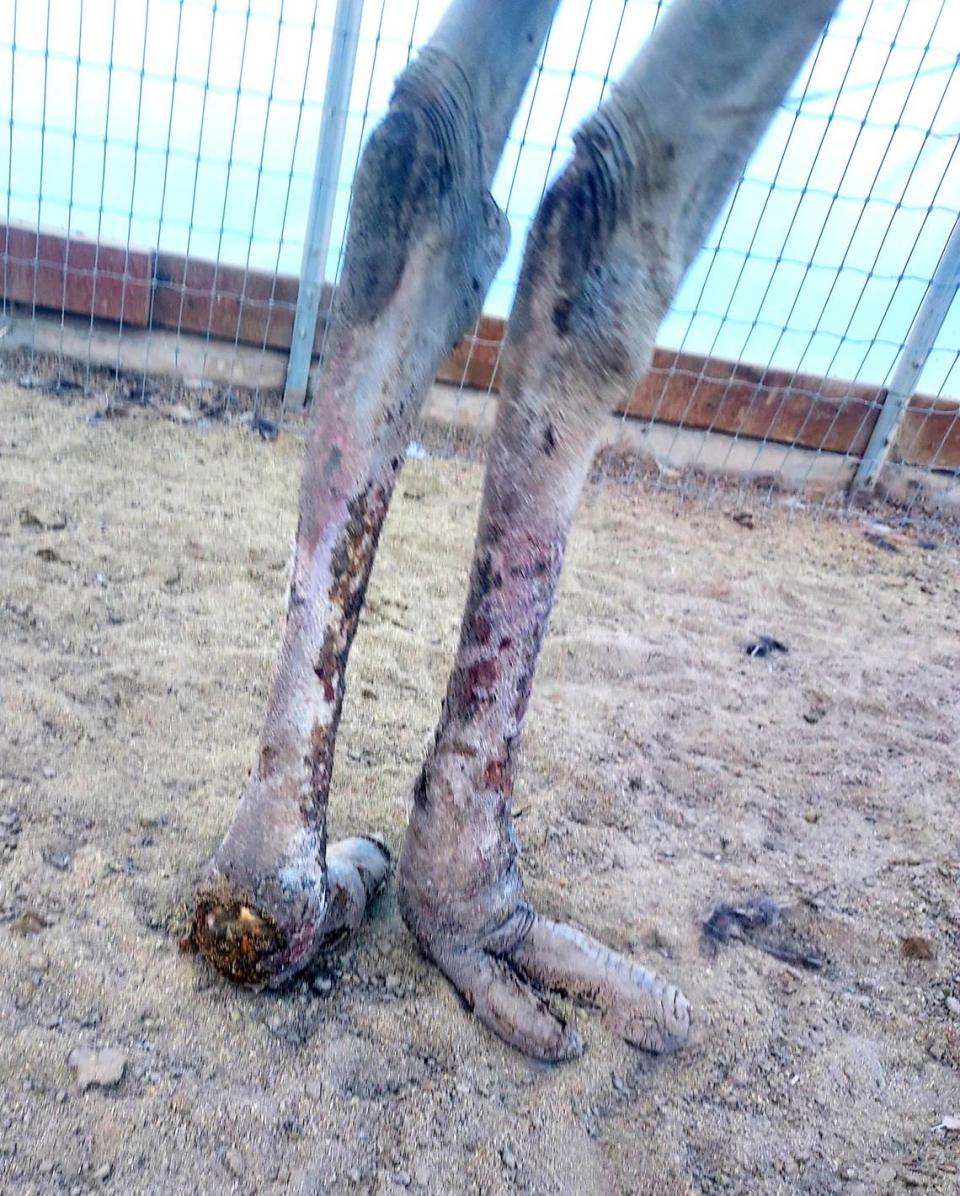
Worman said she helped move the ostriches to a greenhouse, and the bird with severe swelling was treated with antibiotics, but it was too late. It was killed the next day, after its foot became septic from an infection.
She said she asked multiple times for the ostrich to be put down the day she found it, posting images of the bird’s split foot in a work group chat on WhatsApp.
But McCoy, the owner, said he’d “seen these guys come back from some pretty bad injuries” and didn’t “want to be too quick to pass judgment, especially for a valuable breeder,” according to screenshots of the conversation Worman shared with the Statesman.
“It suffered for no reason, like so many of the birds there,” Worman said.
She said she found multiple other ostriches that morning that had frozen to death overnight. She said birds that died under those circumstances were often still processed for meat.
McCoy said in an interview with the Statesman that it’s inevitable that one or two birds a year get frostbite, and that the farm does its best to avoid it entirely. He said that if an ostrich does get frostbite, the animal is put down and not processed at the slaughterhouse.
‘They’re dying in huge numbers’
Henderson, 41, worked at American Ostrich Farms from September 2022 to March. She said the farm struggled to hire local veterinarians, which made it difficult to provide sufficient care for birds with injuries or ailments. She said she reached out to veterinarians as far away as Washington State University in Pullman and Wildlife Safari in Winston, Oregon, to help with routine care for the birds and access to antibiotic medication.
She said a lack of adequate shelter contributed to a significant mud problem, which caused the birds to slip or splay their legs, sometimes resulting in injury or death. Worman detailed similar concerns in her complaint.
When the snow melted last winter, the ostriches in the juvenile pens were standing in roughly 6-8 inches of cold slop, without access to dry ground, Henderson said. Because of the conditions, 53 of the 350 breeding birds died between October and March, she added.
“They’re dying in huge numbers, huge numbers,” Henderson said.
McCoy could not say how many died last winter.
“I don’t have exact numbers,” he said. “We have thousands of birds. From time to time, you’re going to have losses. All animal production facilities have losses and we are no different. In fact, we are having our best season yet — our hatch rates are up, our mortality is down.”
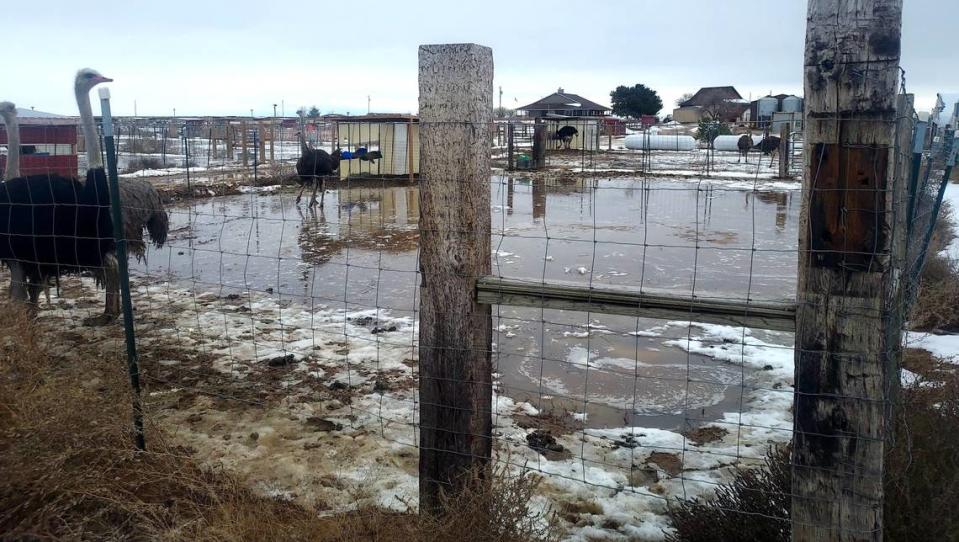
The oldest ostrich at American Ostrich Farms, which died this year, was 7 years old, Henderson said. Ostriches in captivity have an average lifespan of 50 years, according to the California Academy of Sciences.
Henderson said the ostriches would struggle to stay warm, especially those with feather loss. She said the stress of their living situation at the farm would cause the birds to repeatedly peck and pull at the feathers of another, damaging the feathers or ripping them out entirely.
Bad cases of feather pecking can lead to the back of the bird being stripped of feathers, according to a 1999 study published by a pair of British researchers. One researcher named in the study said the abnormal behavioral problem is initiated by inadequate animal husbandry techniques. The researcher found that feather pecking was frequently observed in ostriches that were kept confined over the Canadian winter.
Once the birds start pecking, it’s hard to break the habit, the study said.
“It would cause the birds to become naked-backed,” Henderson said. “They’d have no feathers on them. Birds in general, and this includes ostriches, turkeys and chickens, they don’t get very fat. They have a small fat layer, but they rely on their feathers to keep them warm.”
McCoy said one possible reason the birds peck one another is because of itchy external parasites, which can be combated by administering antiparasitic drugs like ivermectin annually. He said he recently discovered that a prior manager had neglected to give the birds such medications over the last two years. That has now been rectified, he said.
Birds bred at a young age
Henderson said she grew up in agriculture, working with horses from a young age and raising butcher hogs for the Future Farmers of America, or FFA. She bred horses for years, worked at a ranch in Meridian and coordinated the annual horse show at the Gem County Fair.
McCoy told the Statesman by phone that he hired Henderson because of her experience with other animals. But she said her input was frequently disregarded.
Henderson said the female ostriches were routinely made to breed at 16 to 18 months old, when they weren’t yet sexually mature. She said employees were told that if a female ostrich could produce an egg, it could breed. According to PBS, ostriches reach sexual maturity at around 3 to 4 years old.
“They were babies. They weren’t ready for breeding,” Henderson said. “But we were told to put them out, so we put them out in the pens.”
She said that with horses and other animals, if the female isn’t willing to be bred, it indicates unreadiness and often results in an unsuccessful pregnancy. She added that some of the young ostriches that were placed in the breeding pens last fall had died by the spring. But the practice continued, she said.
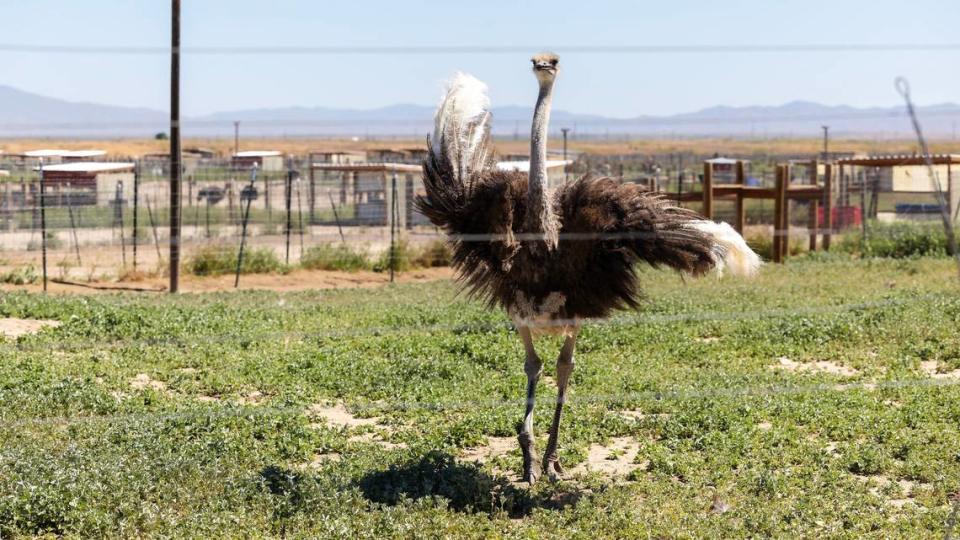
McCoy said that all of the farm’s breeding hens are over 2 years old. He said it’s “not physically possible” for a young, female ostrich to be bred if it doesn’t want to breed. He said he’s visited ostrich farms around the globe, including in South Africa, Brazil, New Mexico, Texas and California, where he learned the best practices.
“Ostriches can run 40 miles an hour,” he said. “If a hen does not want to be bred, it just moves away. It would run, and that rooster has no way to pin it down. It doesn’t have any arms. It doesn’t have four legs.”
Henderson said the birds often weren’t able to get away.
She said that in those circumstances the male ostrich would chase the young female until it either stopped out of exhaustion or ran into a fence and fell to the ground. Then, the male “would jump on them and rape them,” she said.
“When you’re doing animal husbandry, part of the job is to recognize the emotional needs of the animals, not just the physical needs,” Henderson said. “Unfortunately, at American Ostrich Farms, they ignore both.”
Worker said ammonia fumes would blind the ostriches
Worman said in the complaint that a number of ostrich chicks went blind in the winter because of high levels of ammonia in their enclosure.
Exposure to continuous or high levels of ammonia fumes, a byproduct of the animals’ urine and feces, is correlated with gastrointestinal irritation and respiratory diseases and a high incidence of contact dermatitis in animals, according to research from Ohio State University.
“One of the guys told me, ‘You’re going to get some calloused skin working here, because they go blind every winter,’” Worman said.
McCoy said these accusations aren’t true. He said ammonia is a common livestock problem that his farm manages by adding material to the soil or turning exhaust fans up.
“It would make no sense for us to not give these birds the best possible care that we can,” McCoy said.
Worman also said there’s a barn for the ostrich chicks that was in disrepair. She said it received little sunlight, causing mold to grow on the walls and maggots to hatch on the ground. The conditions caused the chicks to huddle together so tightly that some suffocated, she said.
In photos Worman shared with the Statesman, over a dozen chicks were pictured huddled together on a rusted metal grate in what she called the “chick barn.” In one photo taken inside the enclosure, four young ostriches were seen splayed on the ground, seemingly dead. Another showed maggots, the larva of flies, on top of a black substance coming through the grate.
“I pushed to get the birds out of there, because it wasn’t healthy,” she said.
McCoy denied that there was mold or maggots in the enclosure. He said the farm tested for mold as a preventative measure late in summer 2023, and the results came back negative. He added that the farm tests the soil in all of the enclosures for fungus and other kinds of bacteria.
“We want to make sure we have healthy air quality,” he said. “And we’ve never found anything that would harm an ostrich.”
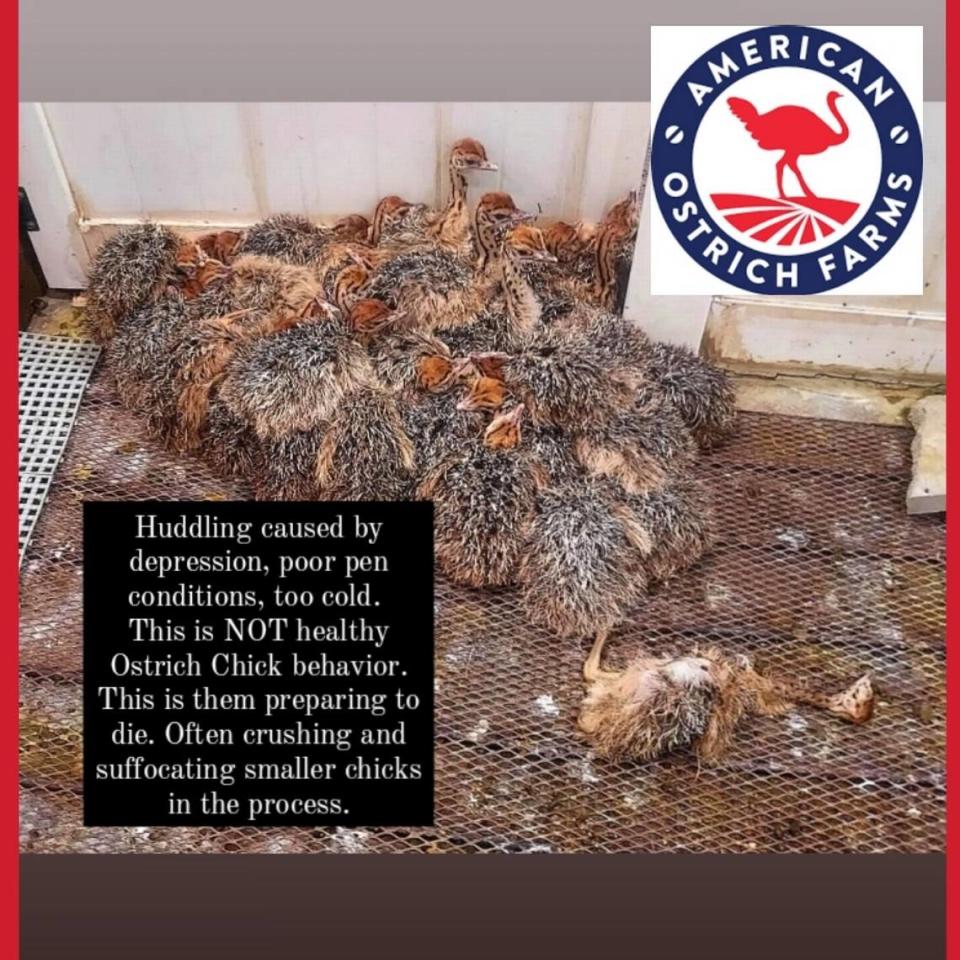
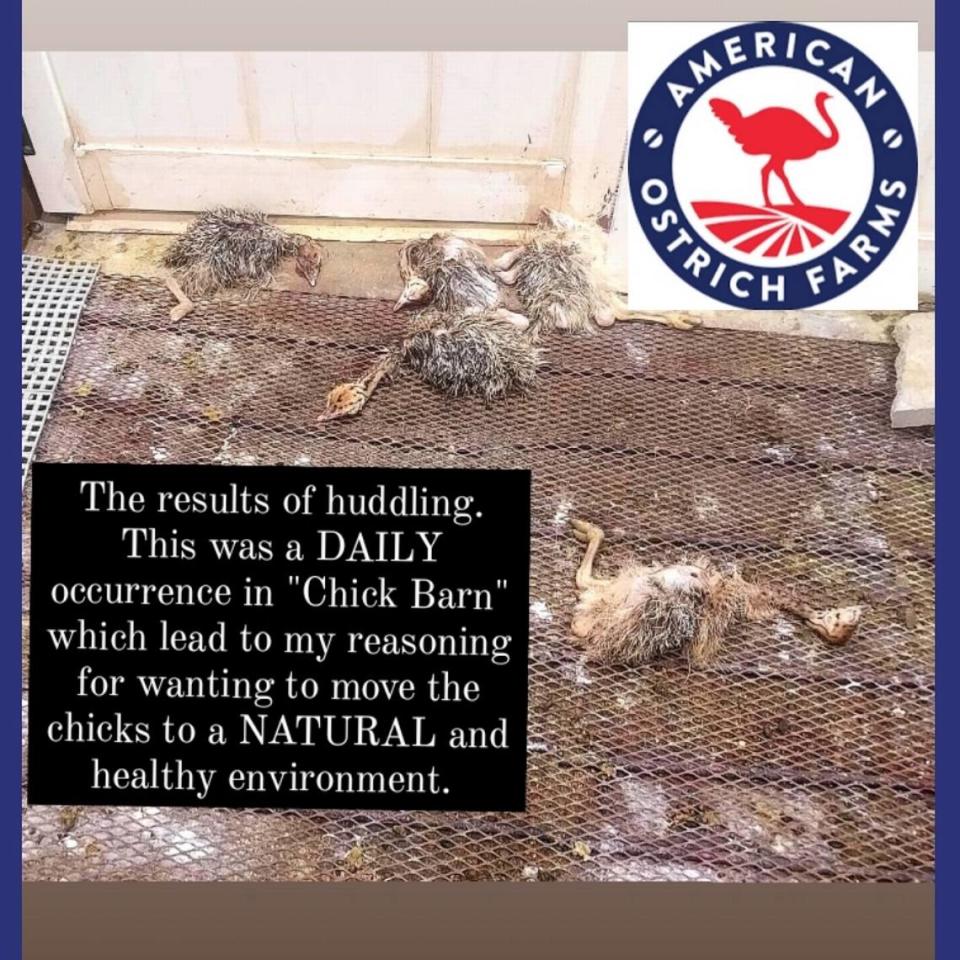
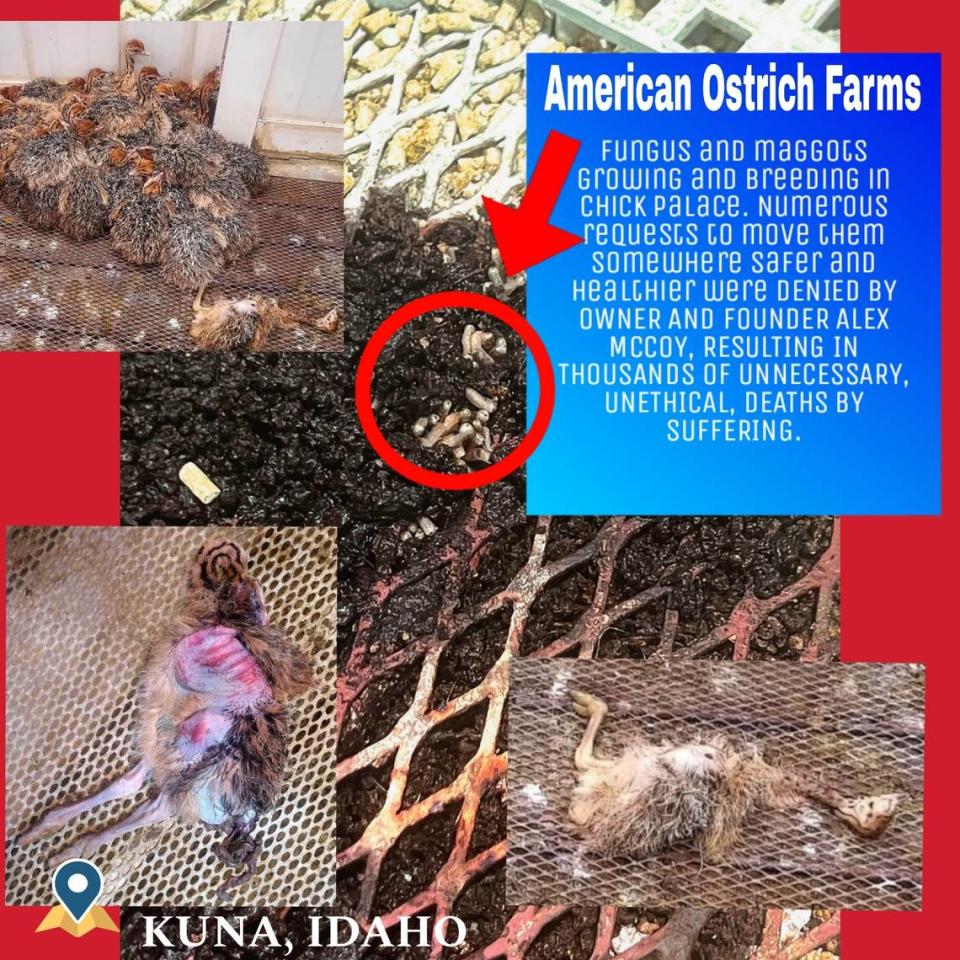
‘Rough handling’ of the birds
Worman and Henderson described how two employees would hit the ostriches with hooks and kick them while yelling expletives, repeatedly thrusting their boots in the animal’s cloaca, or rear end, to try to lift them up. Some birds would accidentally run into fences as they tried to get away, breaking their wings or skinning their legs, they said.
They said the ostriches would lie down when faced with what seemed like a threat, and that leaving the animal alone for a few minutes was more effective at getting them to move.
“One of the things that stood out to me almost immediately within the first month I was there was that once the birds get to a certain amount of stress, they kind of just give up and sit down,” Worman said. “But the quieter and calmer you are — they get back up and you can move them just fine.”
Worman noted these concerns in the complaint with the Idaho Department of Agriculture. She said in the complaint that she sometimes observed other workers stepping on the birds’ necks to hold their heads down before shooting them. She said others would cut the animals’ throats while they were still conscious, causing them to cry out and flail while bleeding to death.
“There was a lot of rough handling that was unnecessary,” Worman told the Statesman.
Ostrich farm denies the allegations
McCoy denied that any animal abuse took place on the farm and said that if it did, his management team would have flagged it. He said American Ostrich Farms has a robust humane handling program at its on-site slaughterhouse, where a USDA inspector is present at all times.
“It’s just not credible,” he said. “One of the worst things that you could ever do is hurt a harmless animal. Why would we do that? It doesn’t make any sense.”
Jess Roth, senior marketing manager at the farm, told the Statesman in an emailed statement that the accusations are “without merit.” She said PETA neglected to perform due diligence to confirm the veracity of the allegations, which she characterized as false, reprehensible and deeply disheartening.
Roth also said the reports from the Idaho Department of Agriculture prove that the farm practices humane and ethical animal husbandry.
State investigation finds no abuse
In February, Worman contacted PETA and shared her concerns. PETA then filed a complaint March 11 with the Idaho Department of Agriculture, based on Worman’s testimony and photos she provided.
In the complaint, Worman said feed for at least half of the birds is poured into mud or broken, leaky feeders, resulting in wet food the birds can’t eat. PETA said several of the allegations mirror a complaint it received about the farm over a year ago, which it wasn’t able to verify at the time because the complainant became unresponsive. The nonprofit said the existence of the previous allegations lended credence to Worman’s testimony.
The complaint was sent to Daniel Chaney, a senior investigator with the department. He forwarded it to Dr. Scott Leibsle, the state veterinarian. Records show Chaney went to the farm two days later, on March 13, for an inspection.
Henderson said Chaney first went to the farm for an inspection March 12 but was refused entry. She said he called her to gain access to the farm that day, but because she wasn’t on site, she couldn’t let him in. So she messaged the work WhatsApp group chat asking if someone else could let the investigator in. She said Chaney called her back and told her an employee denied him access and asked him to come back the next day. So he did.
McCoy said the inspector wasn’t let in because he had arrived around 5 p.m., after nearly every employee had gone home. Only one person remained, and that person was not involved in handling the animals, he said.
In the investigator’s report, which the Statesman obtained a copy of, Chaney rated the general condition of the animals and the condition of the farm as fair. He wrote that he did not find any sick or injured animals during his visit.
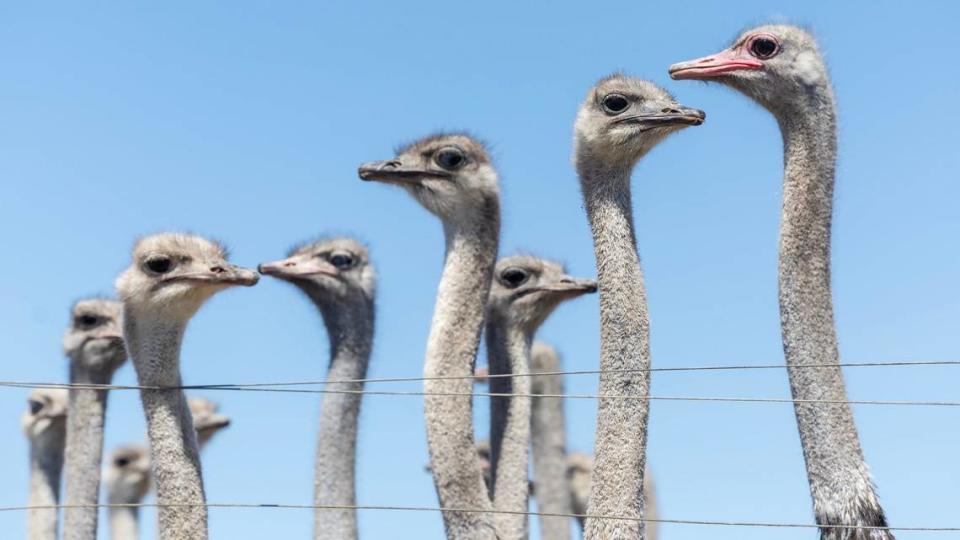
Chaney said that while the pens were damp with sandy soil and water pooling in low spots, there were elevated areas where the birds could get relief. Each corral had a three-sided shelter, he said.
He observed that several of the younger, female breeding ostriches had a “more pronounced spinal column, which could be indicative of under-conditioning,” he said, meaning the birds are thin.
He wrote that the indoor chick-raising facilities were clean and in good repair.
Chaney said there was no strong ammonia smell in any of the enclosures, and there was no evidence of blind birds. He also said he did not see any abuse or mishandling of the ostriches.
Because of the seriousness of the allegations, Chaney conducted a follow-up inspection May 29. In that report, he said that while he toured the farm, a new flock manager described changes that had been made to improve productivity.
“The water troughs are now being cleaned regularly and the birds’ feed has been changed,” Chaney wrote. He “found no deficiencies in the facility or animal care at this time.”
A spokesperson for the department told the Statesman by email that the investigation was closed. Chaney did not respond to a request for comment.
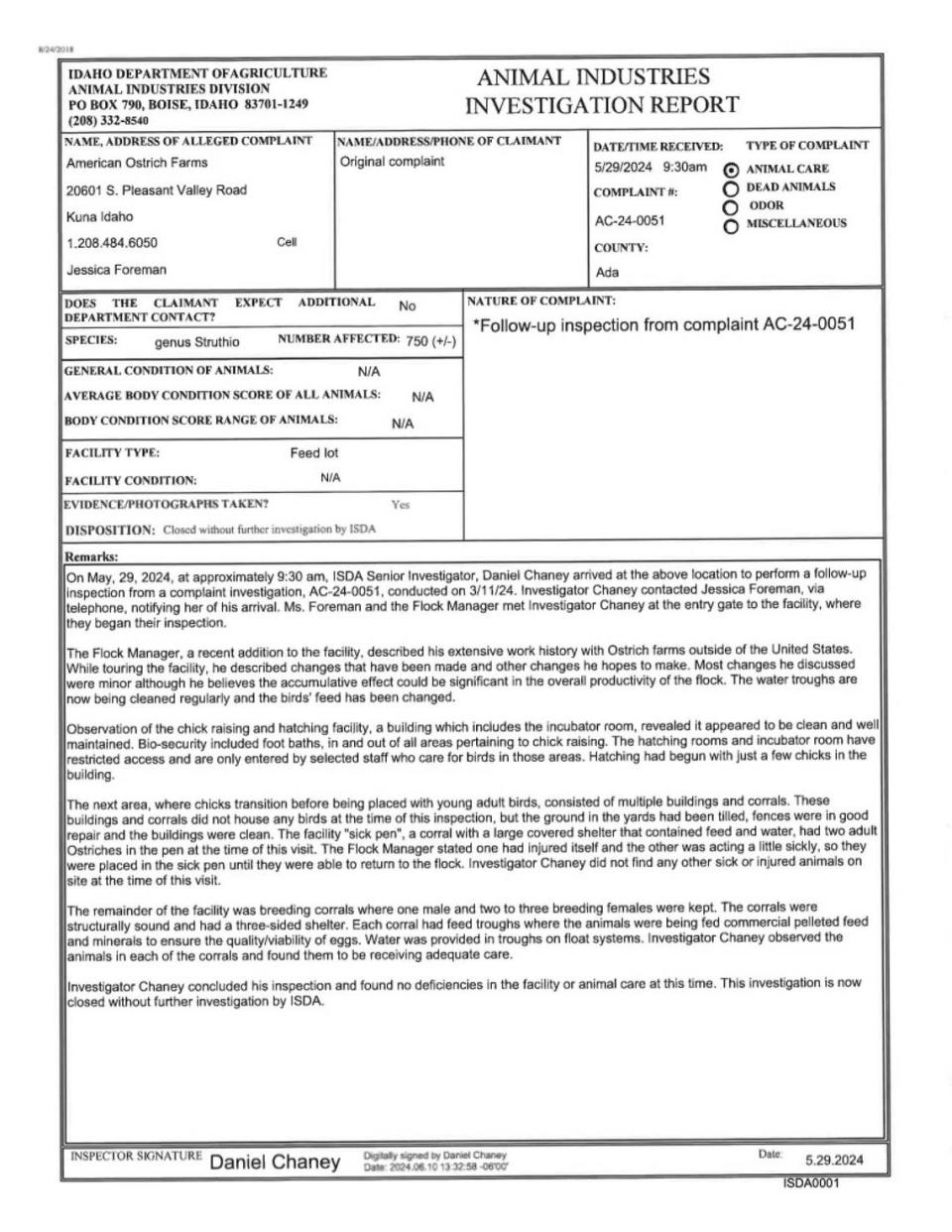
PETA ‘not convinced’ by report, company’s statements
Dan Paden, vice president of legal advocacy at PETA, told the Statesman by phone that PETA had spoken with six former employees of the farm who corroborated the allegations.
“We’re certainly convinced that these people are speaking the truth,” Paden said. “Obviously, we object to raising any animals for flesh, but even putting that aside, these animals deserve protection under state law, and we’re not convinced that they’re getting it.”
Paden also said the farm had up to two weeks’ notice to prepare for a potential inspection, since Worman had publicly raised her concerns about the animals’ welfare several times on Facebook beginning Feb. 28.
“That’s not enough time to hide every problem on the farm, but certainly it’s enough to kill off the worst-looking animals and tell your employees to be under their best behavior in case a state inspector shows up,” he said.
Reporter, photographer tour farm
A Statesman reporter and photographer toured the farm on a hot June day with Roth, the marketing manager, and Jimenez, the farm’s plant manager.
Each pen appeared to have a small shelter and food and water troughs.
The employees pointed out a male bird in a breeding enclosure near the farmhouse. The bird later picked at the back-end of a female bird, pulling at her feathers with its flat beak. A handful of ostriches in the breeding pens seemed to have little to no plumage on their backs, a sign a feather pecking, according to the British research. Though both genders can be affected, the study said female ostriches are more likely to peck and be pecked.
The Statesman was not able to enter the chick enclosure because of precautionary measures related to bird flu.
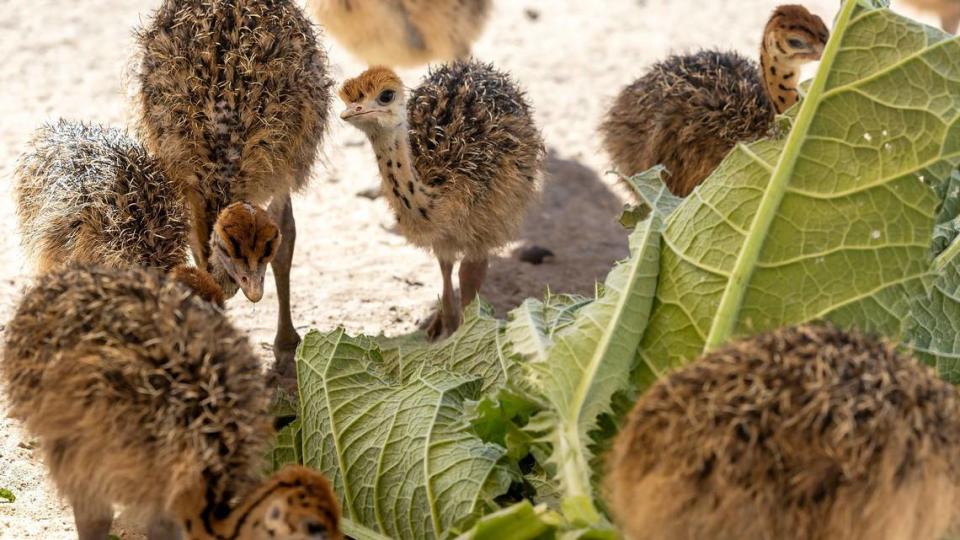
Roth and Jimenez showed the reporter and photographer a group of chicks kept outside in a greenhouse-like structure with an overhead covering.
The Statesman reporter and photographer did not smell ammonia near any of the enclosures during the roughly 30-minute visit. They also did not observe abuse or mishandling of the ostriches.
Worman and Henderson were fired
Roth said Worman was fired for consuming illegal drugs on shift. Worman said she was fired after using a THC vape pen in the bathroom at the farmhouse, even though other employees used the same drug while clocked in and were not fired. She said that prior to the incident, other employees had held private meetings where they conspired to get her fired.
Worman said she now works part time as a ranch hand and walks dogs, cleans homes, mows lawns and does tree removal on the side.
Henderson said she was dismissed for cooperating with the state’s investigation. Chaney had contacted her with questions, which she answered, and she was let go via email the next day, she said. Henderson said she’s been on unemployment since the end of March.
Roth told the Statesman by email that mortality, injury and illness are unfortunately bound to occur in any livestock operation.
“Documenting these incidents allows the ranch to identify causes and mitigation measures, as well as to inform treatment plans and track progress,” Roth wrote. “As one might imagine, it is quite easy to selectively present such imagery in a false or fabricated context, especially when an individual harbors ill intent.”
Worman and Henderson said they were spurred by concern for the well-being of the large, exotic animals.
“From the first day I walked in, I was bothered by the conditions,” Worman said. “But I thought, ‘Well, I can make a difference here. I can make a real difference for these animals.’ I made that my whole mission there. It was heartbreaking.”

